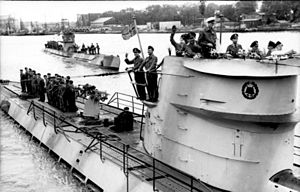 U-123 and U-201 leaving Lorient on 8 June 1941.
| |
| Class overview | |
|---|---|
| Operators | |
| Preceded by | Type IXA submarine |
| Succeeded by | Type IXC submarine |
| Built | 1938–1940 |
| In service | 1939–1945 |
| In commission | 1939–1945 |
| Planned | 14 |
| Completed | 14 |
| Lost | 14 |
| General characteristics | |
| Displacement |
|
| Length |
|
| Beam |
|
| Height | 9.60 m (31 ft 6 in) |
| Draft | 4.70 m (15 ft 5 in) |
| Speed |
|
| Range |
|
The German Type IXB submarine was a sub-class of the German Type IX submarine built for Nazi Germany's Kriegsmarine between 1938 and 1940. The U-boats themselves were designed to be fairly large ocean-going submarines. The inspiration for the Type IXB submarine came from the earlier original Type IX submarine, the Type IXA submarine. The design of the IXA was developed to give an increased range, a change which resulted in a slightly heavier overall tonnage. This design was improved even further in the later Type IXC submarines.
The class comprised 14 submarines, U-64, U-65, U-103, U-104, U-105, U-106, U-107, U-108, U-109, U-110, U-111, U-122, U-123, and U-124; thirteen were sunk during the war and the last scuttled by its crew at the end of the war. The Type IXB submarines were the most successful class of submarine in the war in terms of the total amount to tonnage sunk, with each U-boat sinking an average of over 100,000 gross register tons (GRT) during its career.[1]
- ^ Helgason, Guðmundur. "Type IXB". German U-boats of WWII - uboat.net. Retrieved 31 May 2010.